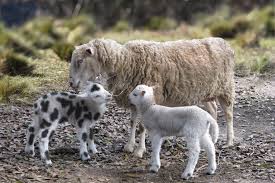Jacob’s Flocks Increase
30: 37-43
Jacob’s flocks increase DIG: How were Jacob’s white strips like Rachel’s mandrakes? How did ADONAI help Jacob prosper in spite of Laban’s cheating?
REFLECT: Are there any superstitions that you substitute for the Lord’s blessing in your life? How has Christ blessed you exceedingly? Do you acknowledge Yeshua’s hand in your prospering? Or do you take credit?
In thwarting Laban’s deceitful plan, Jacob took fresh-cut branches from poplar, almond and plane trees and made white strips on them by peeling the bark and exposing the white inner wood of the branches (30:37). There is a play on words here. Laban’s name means white, or laban. As Jacob (Hebrew: Ya’akov) peeled back the bark on the branches of the trees, and exposed the white, or laban, he saw his flocks grow. In other words, Ya’akov used the white or laban branches to defeat whitey.484
Then Jacob placed the peeled, striped branches in all the watering troughs, so that they would be directly in front of the flocks when they came in to drink (30:38). This accepted, but unfounded superstition believed that when something distinctive, like peeled branches, was viewed during conception, it would leave its mark on the embryo.485
Laban’s dark brown or black goats mated in front of the branches. And, surprise, surprise, they bore young kids that were streaked or speckled or spotted, so those were Jacob’s according to the agreement (30:39). Laban’s white sheep would do the same thing. They mated in front of the branches, and they too bore young lambs that were dark brown or black. Once again, these would then be Jacob’s.
Ya’akov was over ninety years old at this time and he had a great deal of experience in raising sheep and goats. He knew that strong parents breed strong lambs and kids. So when the animals did conceive, Jacob would then set apart the young of his flock by themselves. He made the rest face the white sheep and dark-colored goats that belonged to Laban three days journey away. Although they could not see them, this might have symbolized Jacob’s confidence that Laban’s dominant colored flock would eventually produce a new recessive colored flock for himself.486 Thus he made separate flocks for himself and did not put them with Laban’s animals (30:40). In this way they would interbreed and produce more recessive colored animals. As a result, he had the beginnings of a flock of his own.
Following the superstition of the day, whenever the stronger females were in heat, Jacob would place the branches in the troughs in front of the animals so they would mate near the branches. But if the animals were weak, he would not place them there. So the weak animals went to Laban and the strong ones to Ya’akov (30:41-42). So what was once true of Laban’s flock, now becomes true of Jacob’s flock. A greater and greater proportion of Jacob’s flock were strong animals, and an increasing proportion of Laban’s flock became weak animals.

In spite of believing this superstition, ADONAI blessed Jacob and he grew exceedingly, or very, very prosperous. There was an explosion of prosperity and he came to own large flocks, and maidservants and menservants, and camels and donkeys (30:43). Here Jacob’s white strips function much like Rachel’s mandrakes. It was not the mandrakes that made her fertile, and it is not the white strips that produced recessive colored animals. The LORD opened Rachel’s womb, and Ya’akov eventually acknowledges in 31:10-12, that it was God, not superstition, that brought an increase to his flock.



Good evening,
I have enjoyed reading this story and I have a question. From the first line, “Jacob’s flocks increase DIG: How were Jacob’s white strips like Rachel’s”, what is DIG?